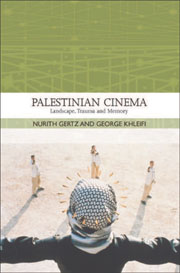Book contents
- Frontmatter
- Contents
- TRADITIONS IN WORLD CINEMA
- Dedication
- Introduction
- 1 A Chronicle of Palestinian Cinema
- 2 From Bleeding Memories to Fertile Memories
- 3 About Place and Time: The Films of Michel Khleifi
- 4 Without Place, Without Time: The Films of Rashid Masharawi
- 5 The House and its Destruction: The Films of Ali Nassar
- 6 A Dead-End: Roadblock Movies
- 7 Between Exile and Homeland: The Films of Elia Suleiman
- Conclusion
- Epilogue
- Bibliography
- Filmography
- Index
1 - A Chronicle of Palestinian Cinema
Published online by Cambridge University Press: 05 August 2013
- Frontmatter
- Contents
- TRADITIONS IN WORLD CINEMA
- Dedication
- Introduction
- 1 A Chronicle of Palestinian Cinema
- 2 From Bleeding Memories to Fertile Memories
- 3 About Place and Time: The Films of Michel Khleifi
- 4 Without Place, Without Time: The Films of Rashid Masharawi
- 5 The House and its Destruction: The Films of Ali Nassar
- 6 A Dead-End: Roadblock Movies
- 7 Between Exile and Homeland: The Films of Elia Suleiman
- Conclusion
- Epilogue
- Bibliography
- Filmography
- Index
Summary
In 1935, Ibrahim Hassan Sirhan filmed a 20 minute-long movie that documents the visit of Prince Saud to Jerusalem and Jaffa. The Saudi Prince was escorted on this occasion by the Mufti of Palestine, Haj Amin al-Husseini. This event constitutes the starting point of Palestinian cinema, whose history is divided into four periods echoing the various stages of the national Palestinian struggle, the topic on which Palestinian cinematic creation has fed and focused. Since the periods tend to stretch and overlap, the years marking their beginning and end are merely suggestions and by no means indicate clear-cut boundaries.
The first period is bracketed between 1935 and 1948, the year of the war that has been referred to as the Naqba (“disaster”), following which most Palestinians were compelled to leave their homeland. Information concerning this period has mostly been gathered from the testimonies of people who, according to their own claims, either initiated or participated in the cinematic undertaking of the era. Notices that were placed in contemporary newspapers and the registration documents of production institutions are additional sources of information. Other than these, no trace of the films produced has remained. Historians who have investigated the cinema of this period have relied exclusively on these pieces of evidence, and so shall we.
- Type
- Chapter
- Information
- Palestinian CinemaLandscape, Trauma and Memory, pp. 11 - 58Publisher: Edinburgh University PressPrint publication year: 2008



